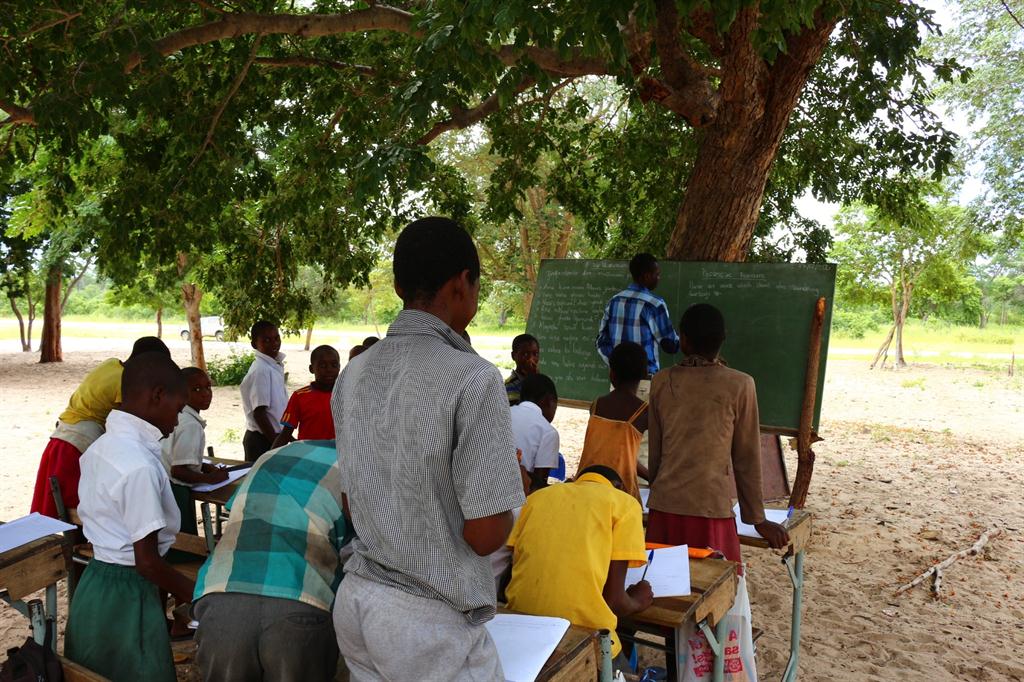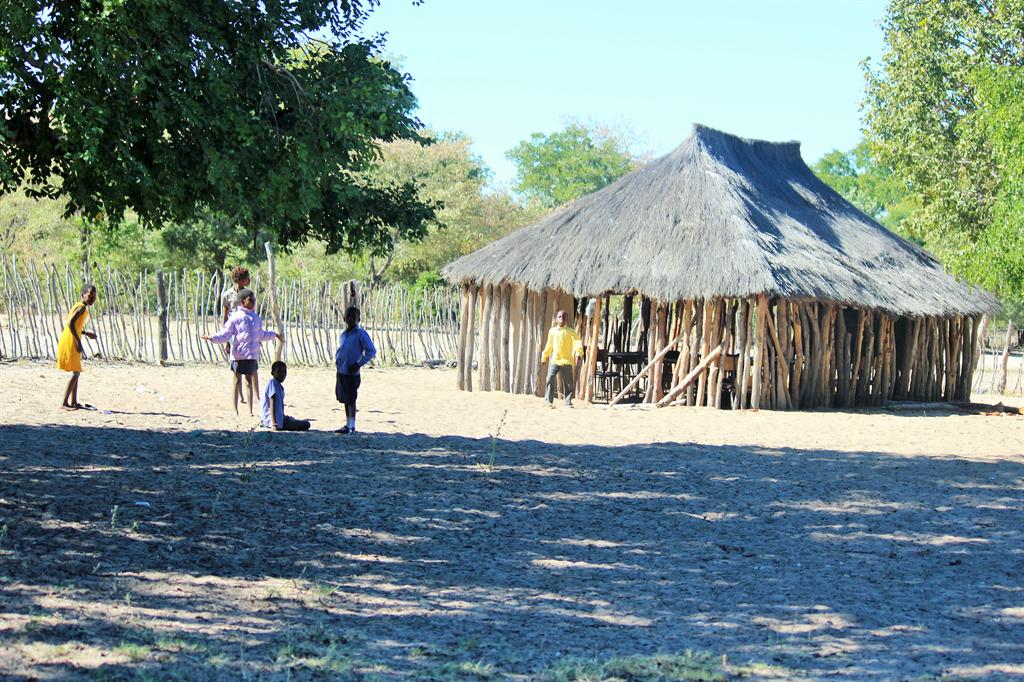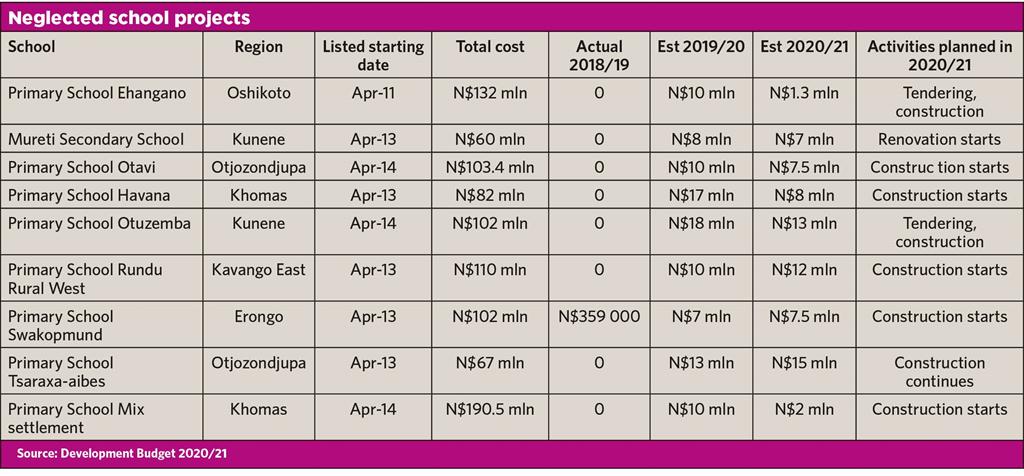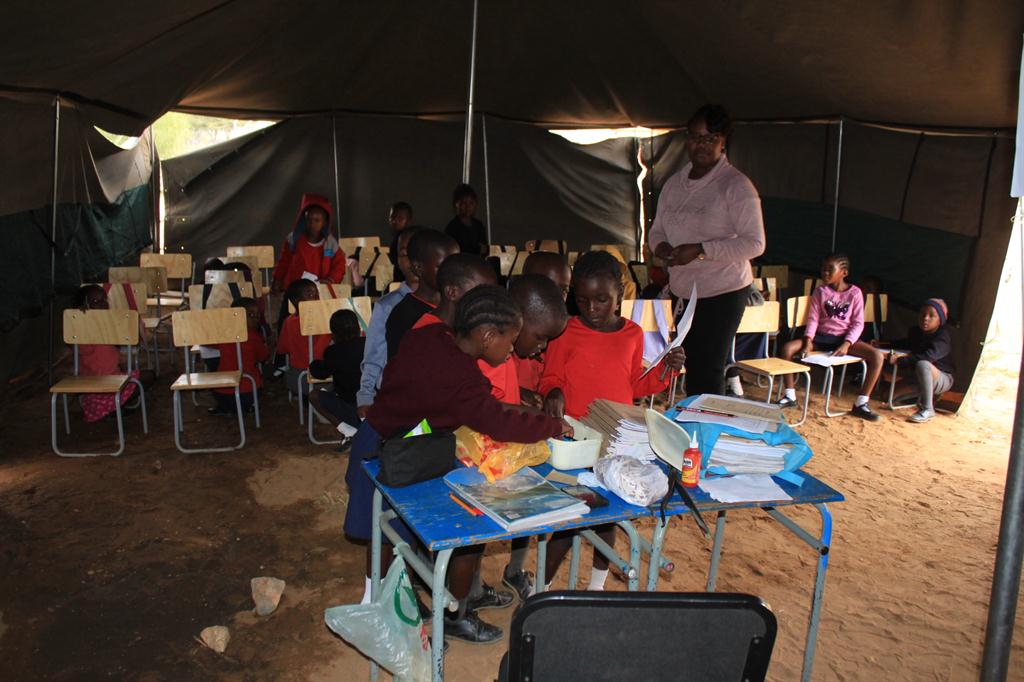Lockdown for new schools budget
Development budgets show that the construction of new schools in Namibia is put on the back burner while government’s spending on items like the wage bill for the bloated civil service continues unabated.
Jo-Maré Duddy – Government in 2018/19 blew more than N$6.6 million wining and dining without spending a single cent on at least eight schools it promised to build countrywide.
The millions could have sped up the construction of these schools which, once completed, will provide 189 classrooms and accommodate more than 4 200 learners.
One of the schools – a primary school in Ehangano in the Oshikoto region – has been in governments’ development budget since April 2011. The other seven have been gathering dust on the shelves of the education ministry since 2012, 2013 and 2014.
Namibia’s education crisis hasn’t taught government any lessons: It intends spending less than 7.8% of the total estimated cost of N$846.9 million of these same eight schools on tendering and the start of construction in the current fiscal year.
In 2019/20, about 11% of the total cost of these schools was spent on design and documentation.
Dumped
A scrutiny of development budgets furthermore shows government seems to have abandoned plans to build about 16 other schools. In the development budgets of 2018/19 and 2019/20, provision was still made for these schools, but there is no mention of them in the 2020/21 documents.
Detailed information about all the projects is not available in the 2018/19 and 2019/20 development budgets, but the schools would have accommodated roughly 9 000 learners upon completion.
It would have been an investment of about N$2 billion in Namibia’s education infrastructure and would have added, among others, more than 300 classrooms.
The projects were supposed to have started in 2012, 2013 and 2014, but the majority of them remained dormant. Completion dates stated in the budget indicated that these schools were supposed to be finished in 2022 and 2023.
Facts and figures
The mid-year budget review of 2019/20 was the last time government’s actual spending on entertainment and refreshments was reported. The N$6.6 million mentioned above is the total ministries and other budget votes paid out for the entertainment of politicians, official entertainment and refreshments.
In the 2020/21 budget, tabled in May this year, these amounts are not available anymore. The entertainment of politicians, official entertainment and refreshments are now grouped together with five other expenses and is reported as “other goods and services”. The estimated budget for this new group in 2020/21 is about N$3.6 billion.
The 2018 Labour Force Survey of the Namibia Statistics Agency (NSA) stated there was 881 676 children younger than 15 years in the country.
According to the Fifth National Development Plan (NDP5), which runs from 2017/18 to 2021/22, government has to build 12 new schools in total – three every year starting 2018/19.
The total target for new classrooms at existing schools over the five-year period is 1 790.
Namibia youth unemployment rate in 2018 was 46%.
A total of 305 981 people from 15 to 34 years were neither employed, nor were they receiving education or training (NEET). Of these, 44 251 were aged 15 to 19.
Of the total NEET number, 65 641 only completed primary school, 129 185 junior secondary and 58 509 senior secondary. 30 973 never attended school.
Abandoned projects
Absent from the 2020/21 development budget is a combined school in Katima Mulilo, envisaged in 2014, which would have been home to 1 200 learners.
Motivating the N$250-million project in the 2018/19 development budget, government said the region and town of Katima Mulilo has a lack of schools.
“At the moment, there are four schools offering a platoon system. This is a problem because lessons are shortened to cater for the double system. The platoon system is not conducive, because of extreme temperatures; the region has high temperatures during summer,” the budget stated.
Also in 2014, government decided to spend N$180 million in total on the construction of a combined school at Aussenkehr to help do away with platoon system.
In the same year, a primary school at Walvis Bay at a cost of N$120 million was planned “in order to cater for the growing number of learners” in the town. “This will terminate the double sessions at some schools and to alleviate pressure on other schools with big numbers of learners in classes and thereby allow individual attention and consequently learner performance,” according to the budget motivation.
‘Overcrowding’
Also scrapped is a primary school at Outapi in Omusati, planned for 800 learners at a total cost of N$57.5 million. The project was necessary to “reduce overcrowding in existing schools and reduce distances currently travelled by learners”, according to the 2018/19 budget.
An N$80-million primary school for 250 children at the Hardap Scheme near Mariental didn’t survive the cut either. In 2018/19, the project was still regarded at crucial: “At the moment, parents who can afford [it] are transporting their children to Mariental for school on a daily basis while those who can’t afford it, their children are not attending school.”
N$110 million budgeted for a hostel at the Tsumis Farm Primary School in the Rehoboth Rural constituency seems to be history. Originally it was regarded as a priority because “farm workers’ children from the Tsumis Farm surrounding are finding it very hard to reach school due to long distances. As a result many opt to drop out of school.”
Government in 2012 planned to start building a primary school for 700 learners at Onguta in Oshana to “alleviate the problem of spaces at schools in the town and the entire constituency”. The total cost of the project, which was omitted in the latest development budget, was N$110 million.
‘Disadvantaged rural learners’
The Vision Secondary School at Epembe in Ohangwena is one of the projects which has disappeared from the latest development budget.
The project, which was supposed to have started in 2013, would have provided a “modern secondary school and hostel accommodation to disadvantaged rural learners.
The N$250-million project targeted, among others, at least 1 300 learners, 30 classrooms and 10 hostel blocks.
N$225 million was budget in 2012 for a secondary school at Grootfontein “as currently there are only two secondary schools in the Grootfontein circuit, and they were built before independence with small capacity, which cannot absorb all the learners who complete grade 7 in the circuit.”
A planned secondary school at Otjomuise, at a cost of N$29.2 million, would have accommodated 1 200 learners from the Windhoek suburb.
‘Quality of education’
The Bravel Primary School in Kavango West was supposed to be upgraded to the tune of N$58 million. It would have granted access to more than 600 learners and provided for15 classrooms and 6 hostel blocks, among others.
Plans dating back to 2013 to construct a secondary school at Etayi in Omusati were also shelved. This project of N$130 million would have accommodated at least 1 500 learners “to improve the quality of education at all levels”.
In 2013, government embarked on building a primary school at Guinas in Oshikoto for a total cost of N$180 million. The school would cater for about 600 “disadvantaged, marginalised and vulnerable children”.
Dating back to 2012, a new primary school was envisaged for Oshakati South, “in order to separate Erundu Combined School into two schools which has a total number of 1 255 learners”. The school, an investment of N$96 million, would accommodate more than 800 learners.
Covid-19
Reports of dilapidated schools have been rife in the media in recent years. With the outbreak of Covid-19 in Namibia, government intends spending N$600 million in 2020/21 on upgrades and renovation in existing schools nationwide.
“In order to ensure the health of teachers and learners … there is a need to provide the required services to the schools with dire needs for portable water, ablution facilities and hostel accommodation,” according to the latest development budget.
As a result, tanks storing 10 000 litres of water will be installed at 193 schools, 580 ablution facilities will be renovated, 774 new ablution facilities will be constructed and hostel accommodation will be built at 86 schools.
The total cost of the project will be N$1.2 billion.
The total development budget for the ministry of education, arts and culture in 2020/21 is an estimated N$895 million, an estimated N$354 million more than in 2019/20, but about N$59 million less than actual spent in 2018/19.
The millions could have sped up the construction of these schools which, once completed, will provide 189 classrooms and accommodate more than 4 200 learners.
One of the schools – a primary school in Ehangano in the Oshikoto region – has been in governments’ development budget since April 2011. The other seven have been gathering dust on the shelves of the education ministry since 2012, 2013 and 2014.
Namibia’s education crisis hasn’t taught government any lessons: It intends spending less than 7.8% of the total estimated cost of N$846.9 million of these same eight schools on tendering and the start of construction in the current fiscal year.
In 2019/20, about 11% of the total cost of these schools was spent on design and documentation.
Dumped
A scrutiny of development budgets furthermore shows government seems to have abandoned plans to build about 16 other schools. In the development budgets of 2018/19 and 2019/20, provision was still made for these schools, but there is no mention of them in the 2020/21 documents.
Detailed information about all the projects is not available in the 2018/19 and 2019/20 development budgets, but the schools would have accommodated roughly 9 000 learners upon completion.
It would have been an investment of about N$2 billion in Namibia’s education infrastructure and would have added, among others, more than 300 classrooms.
The projects were supposed to have started in 2012, 2013 and 2014, but the majority of them remained dormant. Completion dates stated in the budget indicated that these schools were supposed to be finished in 2022 and 2023.
Facts and figures
The mid-year budget review of 2019/20 was the last time government’s actual spending on entertainment and refreshments was reported. The N$6.6 million mentioned above is the total ministries and other budget votes paid out for the entertainment of politicians, official entertainment and refreshments.
In the 2020/21 budget, tabled in May this year, these amounts are not available anymore. The entertainment of politicians, official entertainment and refreshments are now grouped together with five other expenses and is reported as “other goods and services”. The estimated budget for this new group in 2020/21 is about N$3.6 billion.
The 2018 Labour Force Survey of the Namibia Statistics Agency (NSA) stated there was 881 676 children younger than 15 years in the country.
According to the Fifth National Development Plan (NDP5), which runs from 2017/18 to 2021/22, government has to build 12 new schools in total – three every year starting 2018/19.
The total target for new classrooms at existing schools over the five-year period is 1 790.
Namibia youth unemployment rate in 2018 was 46%.
A total of 305 981 people from 15 to 34 years were neither employed, nor were they receiving education or training (NEET). Of these, 44 251 were aged 15 to 19.
Of the total NEET number, 65 641 only completed primary school, 129 185 junior secondary and 58 509 senior secondary. 30 973 never attended school.
Abandoned projects
Absent from the 2020/21 development budget is a combined school in Katima Mulilo, envisaged in 2014, which would have been home to 1 200 learners.
Motivating the N$250-million project in the 2018/19 development budget, government said the region and town of Katima Mulilo has a lack of schools.
“At the moment, there are four schools offering a platoon system. This is a problem because lessons are shortened to cater for the double system. The platoon system is not conducive, because of extreme temperatures; the region has high temperatures during summer,” the budget stated.
Also in 2014, government decided to spend N$180 million in total on the construction of a combined school at Aussenkehr to help do away with platoon system.
In the same year, a primary school at Walvis Bay at a cost of N$120 million was planned “in order to cater for the growing number of learners” in the town. “This will terminate the double sessions at some schools and to alleviate pressure on other schools with big numbers of learners in classes and thereby allow individual attention and consequently learner performance,” according to the budget motivation.
‘Overcrowding’
Also scrapped is a primary school at Outapi in Omusati, planned for 800 learners at a total cost of N$57.5 million. The project was necessary to “reduce overcrowding in existing schools and reduce distances currently travelled by learners”, according to the 2018/19 budget.
An N$80-million primary school for 250 children at the Hardap Scheme near Mariental didn’t survive the cut either. In 2018/19, the project was still regarded at crucial: “At the moment, parents who can afford [it] are transporting their children to Mariental for school on a daily basis while those who can’t afford it, their children are not attending school.”
N$110 million budgeted for a hostel at the Tsumis Farm Primary School in the Rehoboth Rural constituency seems to be history. Originally it was regarded as a priority because “farm workers’ children from the Tsumis Farm surrounding are finding it very hard to reach school due to long distances. As a result many opt to drop out of school.”
Government in 2012 planned to start building a primary school for 700 learners at Onguta in Oshana to “alleviate the problem of spaces at schools in the town and the entire constituency”. The total cost of the project, which was omitted in the latest development budget, was N$110 million.
‘Disadvantaged rural learners’
The Vision Secondary School at Epembe in Ohangwena is one of the projects which has disappeared from the latest development budget.
The project, which was supposed to have started in 2013, would have provided a “modern secondary school and hostel accommodation to disadvantaged rural learners.
The N$250-million project targeted, among others, at least 1 300 learners, 30 classrooms and 10 hostel blocks.
N$225 million was budget in 2012 for a secondary school at Grootfontein “as currently there are only two secondary schools in the Grootfontein circuit, and they were built before independence with small capacity, which cannot absorb all the learners who complete grade 7 in the circuit.”
A planned secondary school at Otjomuise, at a cost of N$29.2 million, would have accommodated 1 200 learners from the Windhoek suburb.
‘Quality of education’
The Bravel Primary School in Kavango West was supposed to be upgraded to the tune of N$58 million. It would have granted access to more than 600 learners and provided for15 classrooms and 6 hostel blocks, among others.
Plans dating back to 2013 to construct a secondary school at Etayi in Omusati were also shelved. This project of N$130 million would have accommodated at least 1 500 learners “to improve the quality of education at all levels”.
In 2013, government embarked on building a primary school at Guinas in Oshikoto for a total cost of N$180 million. The school would cater for about 600 “disadvantaged, marginalised and vulnerable children”.
Dating back to 2012, a new primary school was envisaged for Oshakati South, “in order to separate Erundu Combined School into two schools which has a total number of 1 255 learners”. The school, an investment of N$96 million, would accommodate more than 800 learners.
Covid-19
Reports of dilapidated schools have been rife in the media in recent years. With the outbreak of Covid-19 in Namibia, government intends spending N$600 million in 2020/21 on upgrades and renovation in existing schools nationwide.
“In order to ensure the health of teachers and learners … there is a need to provide the required services to the schools with dire needs for portable water, ablution facilities and hostel accommodation,” according to the latest development budget.
As a result, tanks storing 10 000 litres of water will be installed at 193 schools, 580 ablution facilities will be renovated, 774 new ablution facilities will be constructed and hostel accommodation will be built at 86 schools.
The total cost of the project will be N$1.2 billion.
The total development budget for the ministry of education, arts and culture in 2020/21 is an estimated N$895 million, an estimated N$354 million more than in 2019/20, but about N$59 million less than actual spent in 2018/19.










Kommentar
Allgemeine Zeitung
Zu diesem Artikel wurden keine Kommentare hinterlassen